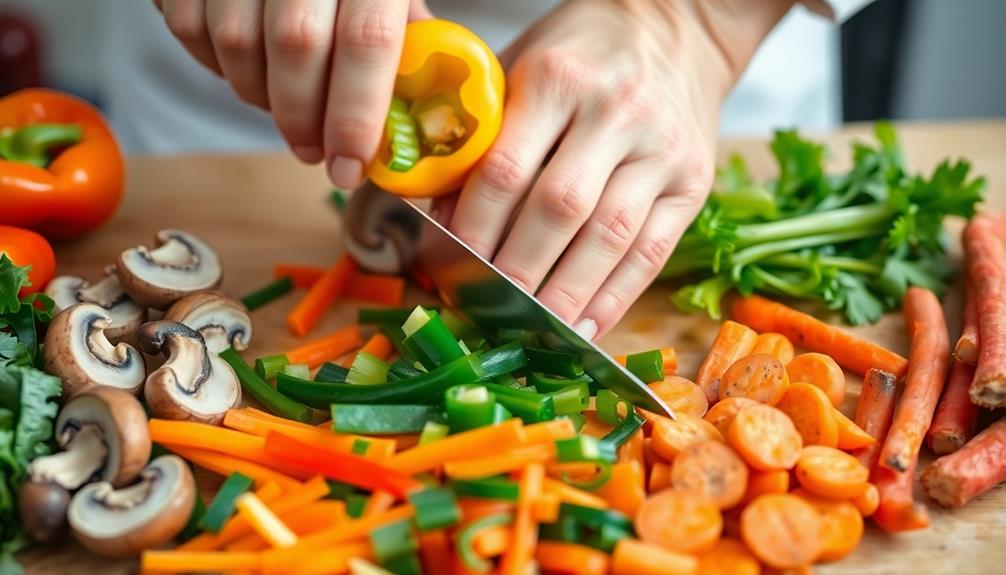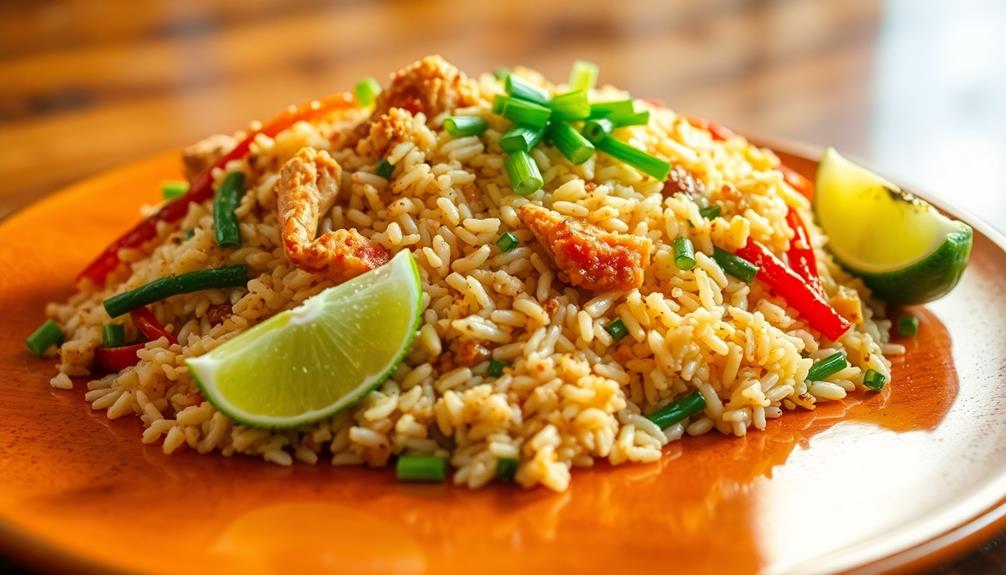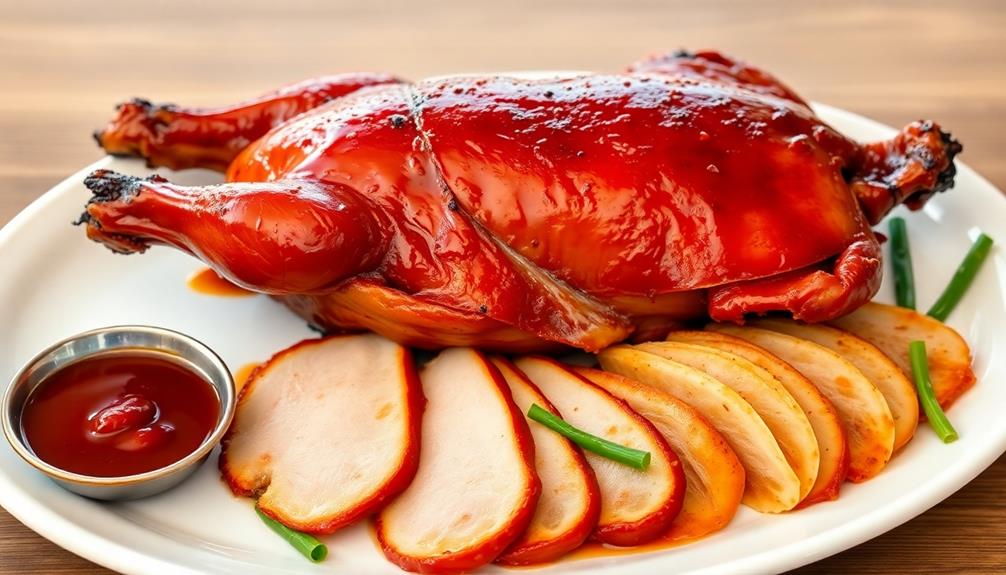You're in for a real treat with Ma La Xiang Guo, the iconic spicy stir-fry from Sichuan, China! This dish packs a punch, combining the numbing sensation of Sichuan peppercorns with the fiery heat of dried chilies. You'll find a medley of fresh veggies like bell peppers, cabbage, and mushrooms, plus your choice of protein – chicken, beef, or even tofu. The key is balancing those bold flavors just right. Get ready to stir-fry your way to a delicious and satisfying meal that'll have your taste buds dancing. And there's more to discover about this beloved Sichuan specialty…
Key Takeaways
- Ma La Xiang Guo is a popular Sichuan dish characterized by its bold, spicy, and numbing flavors, achieved through the use of Sichuan peppercorns and dried chilies.
- The dish features a variety of vegetables, such as bell peppers, cabbage, carrots, and mushrooms, along with protein options like beef, chicken, or tofu.
- The cooking process involves stir-frying the ingredients at high heat, with a focus on balancing the spicy, salty, and umami flavors through the use of sauces and seasonings.
- Customization is a key aspect of Ma La Xiang Guo, allowing for the incorporation of different proteins, vegetables, and spice blends to suit individual preferences.
- Serving the dish immediately and garnishing with fresh herbs can enhance the aromatic and sensorial experience of this beloved Sichuan comfort food.
History
Ma La Xiang Guo's origins can be traced back to the Sichuan province of China, where the dish was first popularized. Sichuan is renowned for its bold, spicy flavors, and this stir-fry is no exception. The name "Ma La Xiang Guo" literally translates to "numbing and spicy fragrant pot," which perfectly captures the signature taste.
The key ingredients in this dish are Sichuan peppercorns, which create a tingling, numbing sensation, and a variety of dried chilies that add a fiery kick. These ingredients are combined with fresh vegetables, protein, and a savory sauce to create a harmonious blend of textures and flavors. One popular dish that features these key ingredients is the Sichuan spicy green beans recipe. The dish typically includes fresh green beans stir-fried with Sichuan peppercorns, dried chilies, and a savory sauce made of soy sauce, ginger, and garlic. The result is a mouthwatering combination of heat, spice, and umami flavors that keeps people coming back for more.
Over time, the dish has evolved, with different regions and households putting their own spin on the classic recipe.
Today, Ma La Xiang Guo has become a beloved comfort food across China and is enjoyed by people of all ages. Whether you're a spice enthusiast or looking to try something new, this dish is sure to tantalize your taste buds and leave you craving more.
Recipe
Ma La Xiang Guo is a spicy and aromatic Sichuan-style stir-fried dish that's immensely popular in China. This dish features a unique blend of Sichuan peppercorns, chili peppers, and a variety of fresh vegetables and proteins, creating a complex and addictive flavor profile. The heat from the chili peppers combined with the numbing sensation from the Sichuan peppercorns offers a bold and unforgettable culinary experience. While Ma La Xiang Guo is loved for its fiery elements, it contrasts beautifully with milder dishes like a delicate **Cantonesestyle steamed fish recipe**, which highlights the natural sweetness of fresh fish. Together, these dishes provide a harmonious balance of flavors, showcasing the diversity of Chinese cuisine.
The key to a delicious Ma La Xiang Guo lies in the careful preparation of the ingredients and the balance of flavors. The Sichuan peppercorns provide a numbing sensation, while the chili peppers bring heat and depth. The combination of these spices, along with the fresh vegetables and proteins, results in a harmonious and unforgettable dining experience.
- Sichuan peppercorns
- Dried chili peppers
- Garlic
- Ginger
- Onion
- Bell peppers
- Cabbage
- Carrots
- Mushrooms
- Protein (such as beef, chicken, or tofu)
- Soy sauce
- Rice vinegar
- Sesame oil
- Cornstarch
- Vegetable oil
To prepare the Ma La Xiang Guo, first, toast the Sichuan peppercorns and dried chili peppers in a dry pan until fragrant. Grind the toasted spices into a powder using a spice grinder or mortar and pestle.
In a wok or large skillet, heat the vegetable oil over high heat. Add the garlic and ginger and stir-fry until fragrant, then add the onions and stir-fry until translucent. Add the bell peppers, cabbage, carrots, and mushrooms, and continue to stir-fry until the vegetables are tender-crisp.
Add the protein and stir-fry until cooked through. Finally, add the soy sauce, rice vinegar, and the ground Sichuan peppercorn and chili powder. Toss everything together and sprinkle with a bit of cornstarch to thicken the sauce. Serve immediately over steamed rice.
When preparing this dish, it's important to have all the ingredients prepped and ready to go, as the cooking process happens quickly. Additionally, be cautious when handling the Sichuan peppercorns, as they can cause a tingling sensation on the tongue. Start with a smaller amount and adjust to your desired level of heat and numbing sensation.
Enjoy the complex and delightful flavors of Ma La Xiang Guo!
Cooking Steps
Soak those dried chili peppers in water to soften them up.
Slice your veggies on the diagonal for a fancier look.
Now it's time to stir-fry everything in the wok, adding that yummy seasoning blend.
Remember to adjust the heat as you go, and serve it all up nice and hot!
Step 1. Soak Dried Chili Peppers in Water

Soaking the dried chili peppers in water is a crucial step in preparing the Ma La Xiang Guo dish. You'll want to do this first before cooking, as it helps soften the peppers and infuses the water with their spicy flavor.
Simply take the dried chilies and place them in a bowl, then cover them with lukewarm water. Let them soak for about 15-20 minutes, or until the peppers have become pliable and the water has turned a vibrant red color.
This spicy-infused water will add an extra punch of heat and aroma to your final stir-fry. Don't forget to give the peppers a gentle squeeze before adding them to the wok – this helps release even more of their fiery essence.
With the dried chilies prepped and ready, you're one step closer to enjoying the mouth-numbing, tongue-tingling delight that's Ma La Xiang Guo!
Step 2. Slice Vegetables Diagonally

Next, slice the various vegetables diagonally. This cut creates longer, thinner pieces that'll cook up nice and quick. Plus, the diagonal slices look super fancy!
Start with your carrots – hold 'em at an angle and carefully slice through, making long, lean carrot coins. Then do the same with your zucchini and bok choy stems.
For the bok choy leaves, slice 'em crosswise into bite-sized strips. The onions get the diagonal treatment too – just peel, slice in half from top to bottom, and then slice each half at an angle. Easy peasy!
This diagonal cutting technique not only helps your veggies cook up fast, but it also makes your dish look extra impressive. Your friends will think you're a real pro chef.
Now that you've got all your veggies prepped, it's time to start stir-frying! Get ready for some serious flavor.
Step 3. Stir-Fry Ingredients in Wok

Fire up your wok over high heat and add a drizzle of oil. Once it's shimmering, toss in the spicy bean paste, garlic, and ginger. Stir-fry these fragrant ingredients until they release their mouthwatering aromas.
Now, it's time to add your sliced veggies. Sizzle the carrots, bell peppers, and leafy greens, giving them a good stir to coat them in the flavorful oil. Don't be afraid to crank up the heat – you want those veggies to get a nice char around the edges!
As they start to soften, pour in the hot chili oil and soy sauce. Toss everything together, making sure the flavors meld.
Step 4. Add Seasoning Blend

Toss in the spicy bean paste, garlic, and ginger into the wok. Give it a good stir to release all those aromatic scents – it'll make your mouth water!
Next, add in the Sichuan peppercorns and dried red chili peppers. These ingredients pack a real punch of heat and tingling sensation. Don't be afraid, though – the other flavors will balance it out beautifully.
Now, pour in the soy sauce, rice vinegar, and a touch of sugar. The salty, sour, and sweet notes will marry together perfectly. Stir everything well so the seasonings coat all the ingredients evenly.
Finally, sprinkle in some ground Sichuan peppercorns and white pepper. These will add an extra layer of complexity and numbing spice.
Give the wok a final toss, and your Ma La Xiang Guo seasoning blend is ready to go! The combination of spices, aromatics, and umami flavors is sure to make your taste buds dance with delight.
Step 5. Adjust Heat and Serve Immediately

Adjust the heat to high at this stage. You're almost done – just a few more steps to go! Crank up that heat to get everything nice and sizzling. This'll help the veggies and proteins get that delicious charred flavor.
Keep a close eye on things and stir constantly so nothing burns. The delightful aromas from the cooking ingredients can enhance your mood, similar to how aromatherapy can stimulate the limbic system and influence emotions.
Once everything is piping hot and the sauce has thickened up, you're ready to serve!
Grab a big ol' bowl and pile in all that spicy, fragrant goodness. The aromas are gonna have your mouth watering, for sure. Sprinkle on some extra Sichuan peppercorns or chili oil if you really wanna amp up the heat.
Don't forget to garnish with some fresh cilantro – it adds a lovely brightness to balance out the bold flavors.
Alright, time to dig in! Grab your chopsticks and get ready for an explosion of mouth-tingling deliciousness. This Ma La Xiang Guo is sure to wake up your taste buds in the best way. Enjoy!
Final Thoughts
Having explored the intricacies of Ma La Xiang Guo, it's time to reflect on the final thoughts.
You've learned how to balance the flavors, adjust the heat, and serve this dish immediately to enjoy its full glory.
Now, consider the versatility of Ma La Xiang Guo. You can easily customize it to suit your taste buds, adding your favorite veggies or proteins.
Don't be afraid to experiment! The beauty of this stir-fry lies in its ability to adapt to your preferences.
Remember, cooking is a journey of self-discovery. With each dish you prepare, you'll gain more confidence and develop your culinary skills.
So, the next time you crave a delightful, spicy adventure, don't hesitate to whip up a batch of Ma La Xiang Guo.
Embrace the challenge, have fun, and savor every bite.
After all, the true joy of cooking is in the journey, not just the destination.
Frequently Asked Questions
What Is the Best Protein to Use in Ma La Xiang Guo?
When it comes to the best protein for your dish, you can't go wrong with a lean cut of beef or pork. Chicken works well too, adding a delicious flavor and tender texture.
How Spicy Is Ma La Xiang Guo Typically?
Ma La Xiang Guo is typically quite spicy, with the level of heat depending on the chef's preference and the amount of Sichuan peppercorns and chili peppers used. It's a dish for those who enjoy bold, intense flavors.
Can Ma La Xiang Guo Be Made Vegetarian or Vegan?
Absolutely! You can easily make a vegetarian or vegan version of this dish by substituting the meat with tofu, mushrooms, or a mix of your favorite vegetables. The key is to maintain the signature ma la flavors.
How Long Do the Leftovers of Ma La Xiang Guo Last?
The leftovers of your dish should last 3-5 days in the fridge when stored properly. Make sure to place them in an airtight container and reheat thoroughly before enjoying the tasty leftovers.
Is Ma La Xiang Guo Suitable for People With Dietary Restrictions?
Whether a dish is suitable for people with dietary restrictions depends on its ingredients. You'll need to check if it contains any items that may conflict with your specific dietary needs.









